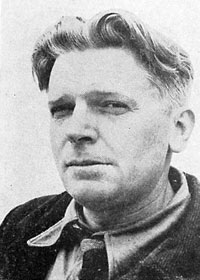|

Pablo O'Higgins (1904-1983)
(P. Pollack,
Graphic Witness) |
O'Higgins, Pablo [formerly Paul Higgins Stevenson]
(1904-1983), artist and art teacher in Mexico,
was born on 1
March 1904 in Salt Lake City, Utah, to a family of
Irish-American origins. His father was a lawyer and his mother
was a farmer. Until 1909 Pablo O'Higgins lived at the family's
ranch 'El Cajon' in California. He was sent to primary school in
Salt Lake City and high school in San Diego and Salt Lake City.
He received
piano lessons, and in 1914 gave his inaugural concert. A year
later he was initiated into the field of painting and his family
relocated to San Diego, California. In 1922, he abandoned his
career as a musician and entered the Academy of Arts in San
Diego. He became acquainted with Diego Rivera in 1924, and
joined the post-revolutionary artistic movement. For two years
up to 1926, Pablo O'Higgins helped Diego Rivera to paint the
murals in the former chapel of Chapingo and the Public Education
Secretariat. His works were exhibited for the first time in 1925
in San Francisco, California. He contributed artwork to
Mexican Folkways magazine and sat on the editorial
committee.
In 1927 Pablo
O'Higgins joined the Mexican Communist Party, and in the
following two years worked on Cultural Missions in
Durango,
Hidalgo,
Veracruz, and Zacatecas. His membership of the Communist Party
would last until 1947. In 1930, he co-published, with Jean
Charlot and Frances Toor, Las obras de José Guadalupe Posada,
a Mexican engraver. In 1931 O'Higgins founded, together with
Leopoldo Méndez and Juan de la Cabada, the Proletarian
Intellectual League. This same year he contributed illustrations
to the Daily Worker, the newspaper of the USA Communist
Party. For this work, he was awarded a grant by the Moscow
Academy of Arts. By 1933, Pablo O'Higgins was teaching drawing
in primary schools. That year he co-founded the Liga de Escritores
y Artistas Revolucionarios (League of Revolutionary Writers and
Artists, LEAR). In 1937, he founded Taller de Gráfica Popular
(Popular Graphics Workshop, TGP), together with Leopoldo Méndez,
who would be implicated in the murder of Leon Trotsky in 1940.
In 1943 O'Higgins's works were exhibited by the Association of
American Artists. In 1948 O'Higgins and Xavier Guerrero founded
Sociedad para el Impulso de las Artes Plásticas, and the Salón
de Plástica Mexicana in 1949. In 1952 he joined the National
Assembly of Artists. His paintings were exhibited at the Salón
de Plástica Mexicana, whose catalogue included commending notes
by Diego Rivera about his work. He also exhibited works at the
Gallery of Mexican Arts.
In 1959 Pablo
O'Higgins married María de Jesús de la
Fuente Casas, a lawyer from Monterrey born in Rayones, Nuevo
León. The same year, he was awarded the first prize by the Salón
Anual de Pintura, Grabado y Escultura of the INBA for his
lithograph 'El chichicuilotero'. In 1961 O'Higgins became a
Mexican citizen in honour of his contributions to the national
arts and education. During his travels in 1968, he gave courses
in mural painting in
Moscow
and Eastern Europe. In 1971 he received the Elías Sourausky
Award in arts.
Pablo O'Higgins
died on 16 July 1983, and a funeral was organised at the Palacio
de Bellas Artes (Palace of Fine Arts). He was buried in Nuevo
León.
Edmundo
Murray
References
-
D@R NL, http://senl.senl.edu.mx/d@rnl/biografia_ohiggins.htm,
accessed 2 February 2007.
- López Orozco,
Leticia (ed.), Pablo O'Higgins: voz de lucha y de arte
(México D.F.: Fundación Cultural María y Pablo O'Higgins, 2005).
- 'Pablo
O'Higgins (1904-1983)' in Graphic Witness, website
(http://www.graphicwitness.org/group/tgpohiggins.htm), accessed
22 February 2007 |


